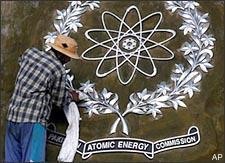Advertisement
How Nukes Spread
Resume
And then it spread: to the USSR, Britain, France, China, Israel, South Africa, India, Pakistan. And that nuclear daisy chain, of course, is not a closed book.
The story of the spies and lies and politics that spread the bomb is little told, and utterly fascinating. Now, an American bomb maker and a nuclear spook are telling it — and warning of where the chain could still go.
This hour, On Point: The secret history of nuclear proliferation, and the threat today.
You can join the conversation. Do you know how the nuclear powers actually got their bombs? China? France? Israel? And where does this go next?Guest:
We're joined from Santa Monica, Calif., by Thomas Reed, and from Los Alamos, New Mexico, by Danny Stillman, co-authors of "The Nuclear Express: A Political History of the Bomb and Its Proliferation." Stillman was former director of intelligence at Los Alamos. Reed was a young nuclear weapons designer at the Lawrence Livermore National Laboratory in the late 1950s. Recruited there at age 26 by Edward Teller, he designed two thermonuclear bombs. He went on to serve as Secretary of the Air Force under Presidents Gerald Ford and Jimmy Carter and as special assistant to President Ronald Reagan for National Security Policy. His previous book is "At the Abyss: An Insider’s History of the Cold War."
More links:
"World at Risk," the report of the Commission on the Prevention of WMD Proliferation and Terrorism, chaired by former senators Bob Graham and Jim Talent, was released in December. It found that "it is likely that a weapon of mass destruction will be used in a terrorist attack somewhere in the world by the end of 2013."
Global Zero, an international initiative launched in December "by 100 political, military, business, faith and civic leaders from across political lines," is developing a plan for "the phased elimination of nuclear weapons."
This program aired on January 8, 2009.